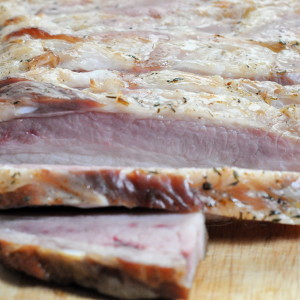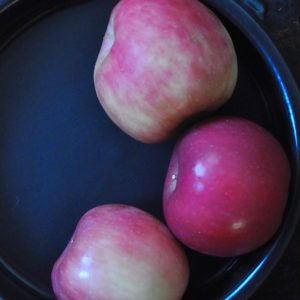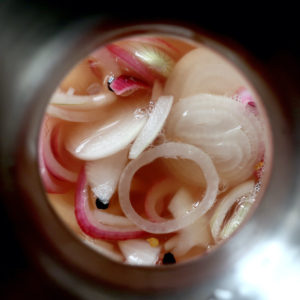Corned Beef Brisket After Jane Grigson
Before discussing today’s recipe, it is only fair to touch on the last post, wherein I ranted and raved about my failed attempt to enroll in an identity theft protection program. This was occasioned by the hacking of my former employer’s antiquated computer system. Alas, attempts to protect my identity failed, as the woman I spoke with could not spell my email. In the ensuing go-round, I reached a second woman, who truly went out of her way, calling me not once but twice to ensure my enrollment. Thanks to her tenacity, I am indeed a member of an identity theft protection program. Whether or not this protects me, or what it protects me from, is another matter entirely. But she’s to be thanked for her efforts.
On to brined beef.
—
There are many things this recipe is not: carefully timed, for starters. I could lie and say I had this lined up for St. Patrick’s Day, finding myself writing about the same topic as nearly everyone else in foodie blogland. In truth, I’ve been sitting on this recipe since last July, and it was only now that I pulled all the elements together to blog it: details, photographs, blah, blah, blah.

The other thing this recipe isn’t, woe unto us, is anything resembling classic Jewish corned beef on rye. So if you’re reading this hoping for a taste of home, I’m sorry. Don’t look for that here. This is delicious corned beef, but it’s not Jewish. If you’re reading this in California and you want deli, get on a plane. Fly right for about four hours. Land. Go to a deli. Eat. That is Jewish deli.
Please don’t start telling me about those new places in downtown San Francisco, late of Montreal, who are really, really doing East Coast Deli. When it comes to food, we Bay Area inhabitants are very spoiled. From Mexican to every variant of Chinese to Ethiopian to Eritrean, Thai to Peruvian to El Salvadoran to Japanese, English Pubs to Italian to plain old California cuisine, we have access to fantastic food. But Jewish food? Not so fantastic. Look, given how good everything else is, we shouldn’t bitch. Too much.
So, brining. Like canning, smoking, and confiting, brining meat was once critical to surviving the winter. Now there is no winter, at least where I live. Instead, there are long stretches of frighteningly warm weather interrupted by frighteningly brief bouts of heavy rain.
When Jane Grigson, whose recipe I’ve adapted, published Good Things in 1971, winter still existed. Finding quality meat was challenging, though, meaning brining:
remains worthwhile for two reasons–it keeps meat on hand and ready to cook, and at no great cost or trouble, and I find little short of miraculous the difference it makes to taste.
Grigson goes on to say that by using the brine she offers “you won’t find the meat salty so much as flavoured in a pleasant way.” She’s right, provided you follow instructions and allow the meat to clear–that is, soak for 24 hours in fresh cold water after 5 days in the pickle. I once tried short-cutting this step with a Fergus Henderson recipe for duck. Henderson, another happy advocate of brining, offers much wisdom on the process in The Whole Beast. Of course I was a fool to think I could skip clearing, and paid the price with inedibly salty food. Learn from my error.

I’d like to say my brining vessel is an enormous, sober French stoneware crock bought at a farm auction. But I use my crock pot insert, found cheaply and less romantically at a garage sale. It does the job nicely.
This is also the time to confess classic recipes for brined beef, called corned beef here in the United States, suggest brining beef 5-7 days, soaking it for 24 hours, then boiling it in fresh water until tender. After attempting this method a good half-dozen times and meeting with tough beef, I have come to the conclusion that brisket does not like to be boiled. Don’t misunderstand: I’ve had great success with short ribs in pot-au-feu and boiled flocks of chickens. But brisket in a pot just doesn’t work for me. If you prefer boiling your beef, by all means, go right ahead. I prefer to braise mine in the oven.

Whether you boil or braise, you gotta brine first. And it must be admitted brined beef isn’t fast food, though the actual work is minimal.The brine simply sits in the fridge, and the cooking itself can happen while you’re doing other things. An added benefit is the beef cooks in water that transforms into a lovely light broth, which may either be frozen or pressure canned. Note that you cannot water bath can meat or poultry broths, as they aren’t acidic enough. Botulism is nobody’s friend.
It must also be said that brisket, like lamb shanks, flank steak, and short ribs, was once a cheap cut that benefited from a salty soak. This is no longer the case; my piece of brisket was fancy organic and cost lots. Call me a crank, but I’d rather pay more for quality meat and eat less of it. A brisket like this is a once in a while treat for us. I’m okay with that.

Corned Beef Brisket After Jane Grigson
Adapted from Jane Grigson’s Good Things and Tamasin Day-Lewis’s Good Tempered Food
Preparation time: 1 hour to prepare and cool brine, 5 days soaking in brine, 24 hours clearing time, approximately 3 hours cooking time.
Serves: 4-8, depending on size of brisket
For the Brine:
3 gallons water
1 1/2 pounds (24 ounces) organic sea salt or best quality sea salt
1 pound (16 ounces) brown sugar
10 black peppercorns, crushed
10 juniper berries, crushed
1 bay leaf
1 large sprig thyme
2-6 pounds brisket, the very best you can afford: my piece was 2 1/2 pounds organic brisket
To cook the Brisket:
fresh water to cover
1 onion, halved
1 head garlic, halved
1-2 carrots, peeled, halved
1 leek, cleaned, halved
1 bouquet garni: thyme, parsley, bay leaf
Make the brine:
In a large pot, bring all brine ingredients except brisket to a rolling boil. Allow to cool completely.
Scrupulously scrub a lidded food-safe plastic, glass, or ceramic vessel that will accommodate the brine and brisket. My crock-pot insert holds 2 1/2 quarts of water, not 3 gallons, but I am able to safely use that. If you have a usable vessel without a lid, you can use foil.
Once the brine is cool, submerge the brisket completely. If it wants to float, weigh it with a clean plate or bowl. I use a small ramekin, filled with brine. Cover and refrigerate for 5 days.
When 5 days are up, rinse brisket well in cool water and submerge in a bowl of fresh cold water for 24 hours. Change the water at least two times. You are ensuring the cooked dish isn’t too salty.
After the 24 hours are up, allow the brisket to come to room temperature. As mentioned, I’ve struggled to successfully cook brisket in boiling water, but here’s the method if you want to:
Put the beef in a large pot with the carrot, garlic, leek, onion, and bouquet garni. Cover with cool water. Bring to a boil, then turn down to the gentlest simmer. Cook for about 3 hours, until beef is tender.
My method:
Preheat oven to 325 F.
In a large ovenproof casserole–Pyrex, enameled cast iron, or similar, lay down the bouquet garni, then the beef. Surround with the vegetables. Add water to cover. Place in oven, uncovered. Cook until beef is tender, about 3 hours.
Either way, check periodically to see if liquid needs topping up. After the first hour, I cut the brisket in half, which kept it submerged without my having to add lots of water.
We love this with sharp mustard, Amora for preference, mashed potatoes, and cooked cabbage. I like to fish out the garlic and onion and serve them, too.
Notes: I did not have a leek when I cooked the brisket this time around, so used a stalk of fresh spring garlic.
If your brown sugar has hardened into cement, take Joy Of Cooking’s suggestion and microwave it: violá! it will soften! But take care, as the sugar will get hot, and you don’t want caramel or burned fingers.
This is how I eat it.

Well, this is how I really eat it…





